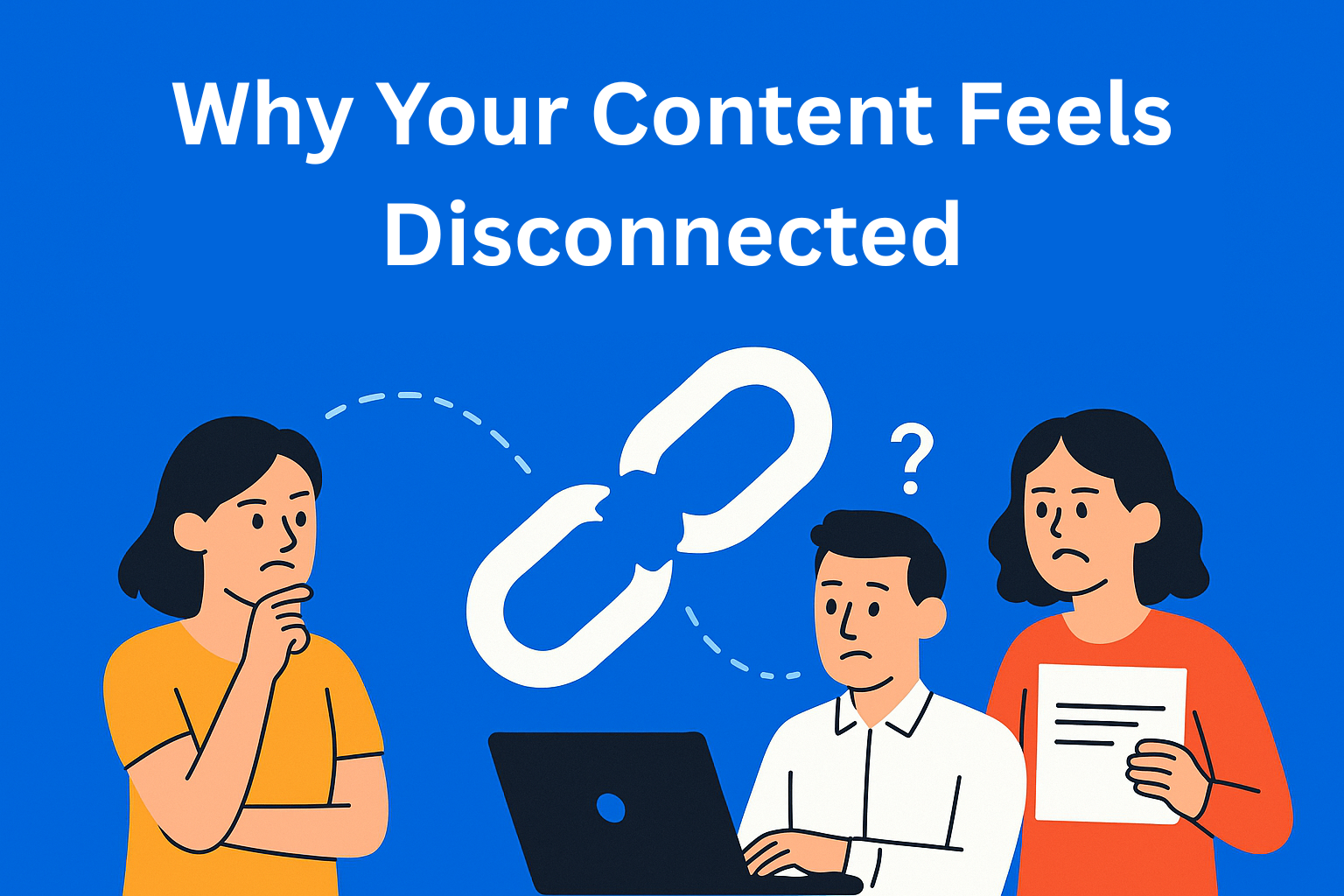Why Your Content Feels Disconnected (and How to Create True Narrative Flow)
Ever feel like your content says all the right things but still doesn’t connect? Learn how to find the gaps in your brand story, align your messages, and build a true narrative flow that makes every piece feel part of one meaningful story.

Have you ever spent hours writing a blog, newsletter, or campaign, and in the end everything looks right - but your audience just doesn’t respond? The titles are catchy, the text is neat, the messages are clear... but something’s missing - that feeling that people truly connect with your brand. If yes, you should know that many teams struggle with the same thing.
The problem isn’t that you lack talent, but that the pieces of your content don’t fit together. Each post might be good on its own, but when they don’t connect into one story, everything feels scattered. Without that flow, the reader sees your messages but doesn’t feel the story. And that story is what makes the difference between content that’s forgotten and content that stays in people’s minds.
Key Takeaways
- Disconnected content lacks a clear story - Even well-written posts won’t resonate if they don’t fit into a larger narrative.
- Narrative gaps confuse your audience - When tone, messaging, and values change from channel to channel, trust erodes.
- A narrative framework keeps everything aligned - Defining your brand’s story, values, and customer journey brings cohesion to your messaging.
- Team alignment is crucial - Consistent tone, voice, and storytelling across departments ensures all content builds the same brand identity.
- Narrative flow creates emotional connection - Content that weaves together themes over time builds trust and keeps audiences engaged.
Where the “Narrative Gap” Happens
A narrative gap is a hole in your brand’s story. It’s that moment when someone follows your brand but can’t quite tell what you actually stand for. Or when your website says one thing, and your email campaign says another. In short, your brand is telling a story that doesn’t match itself.
The most common causes are pretty simple:
- Teams work separately. The content, marketing, sales, and social media teams often have their own versions of the truth.
- No clear main story. The focus is on individual campaigns instead of the bigger picture.
- Messages change too often. Every new campaign shifts the tone, values, and focus.
- The audience’s context is forgotten. People don’t see how each piece of content fits into the whole.
For example, your blog might talk about authenticity and community, while your newsletter aggressively pushes discounts. No wonder your audience doesn’t know what to think of you.
How to Recognize Where the Story Breaks
Before you can fix your story, you need to know where it breaks. Here are a few signs that your narrative isn’t connected:
- People can’t clearly explain what your brand represents.
- Your messages seem contradictory - for example, one day you talk about trust, and the next about fast delivery.
- Your tone of voice changes between your blog, emails, and social media posts.
- Your team has different ideas internally about your brand’s main values.
Here’s a quick test: ask three team members to describe your brand in one sentence. If their answers aren’t similar, you’ve got a problem.
All parts of your content should come from the same main idea. If that idea gets lost, your content might look correct and useful, but people may not connect with your brand emotionally.
From Idea to Message: How to Build a Narrative Framework
A narrative framework is like the skeleton of your communication. It connects every sentence, video, email, and post into one logical whole. It’s the map that shows where each message fits into the bigger story.
Here’s how to create it:
- Define your main story (core story) - this is simply the reason your brand exists. You don’t need a fancy slogan. What matters is knowing the emotion you want to share with people. For example: “We want to make people’s everyday lives easier.”
- Define your main values - these are the things your brand believes in, such as trust, simplicity, or support. Those values should be felt in every message you send.
- Follow the customer journey - think about how people discover your brand: first they see you, then they explore, and finally they buy. For each stage, send them a message that makes sense at that moment.
- Keep the same tone - whether you’re writing a blog, an email, or an Instagram post, make sure your brand always sounds the same - warm and recognizable.
Think of your narrative framework as a system where every word has its place. Once you set it up, creating content becomes easier, and your messages naturally feel more aligned.
How to Align Teams and Channels
Even the best framework won’t work if not everyone uses it. Connected content means all teams need to share the same story. That doesn’t mean everyone writes the same way - it means they understand the same context.
Here’s how to achieve that:
- Create a brand voice guide. A simple document that defines the tone, style, and words your brand uses.For example, if you use a platform like EasyContent, you can create templates for each type of content and include your brand voice guide inside. That way, every piece of content will have the same tone and style you defined.
- Hold monthly alignment meetings. During these meetings, teams can share content and check if their messages are consistent.
- Use story pillars. These are 3-4 main themes that run through everything you create. For example: trust, support, or simplicity.
For example, if your pillar is “small things that mean a lot,” your blog can talk about everyday small wins, your newsletter can share simple tips for an easier day, and your campaign can show products that make life simpler. Each message is different, but together they tell the same story.
How to Create Narrative Flow That Connects Everything
Simply put, narrative flow means that each message naturally connects to the next and together they guide people through your story. Not every post has to directly connect - what matters is that everything makes sense together and tells the same story.
You can achieve this using a principle called content weaving - connecting topics so they build one bigger story. For example:
- A blog explains why authenticity matters.
- A newsletter shows how you put that into practice.
- A campaign invites people to be part of that authenticity.
All three pieces are tied together by one idea - and together they create narrative flow. When your audience sees the same emotion and value across different formats, it builds trust.
If you want to go a step further, use a simple tool or document to map out the stories you tell every week or month. You’ll quickly see where there are gaps or where your messages go in different directions.
Conclusion
In the end, remember: the goal isn’t to make more content. The goal is to make connected content that makes sense and unites everything your brand says. When every blog, email, and post sound like part of the same story, you build recognition.
Ask yourself - What’s the essence of my story, and how does every message I share connect to it? If you can answer that, you’re already halfway to real narrative flow.
In a world where people scroll fast and rarely stop, what keeps them engaged isn’t a perfect sentence - it’s a story with heart. And that story begins the moment your content starts speaking with one clear voice.






